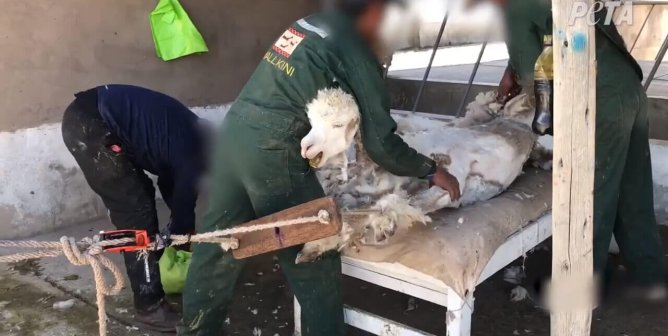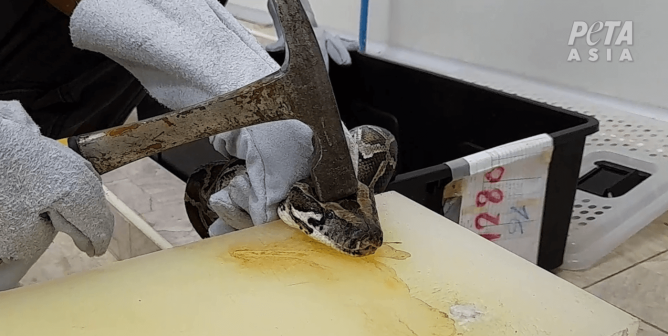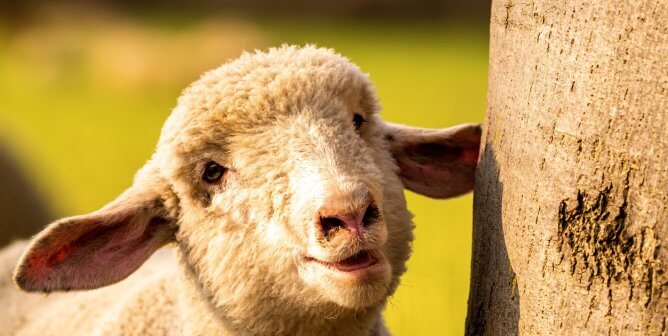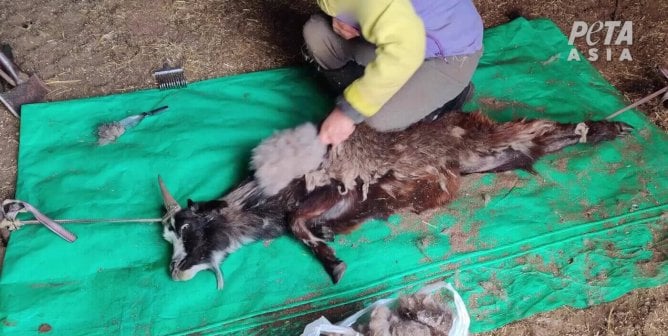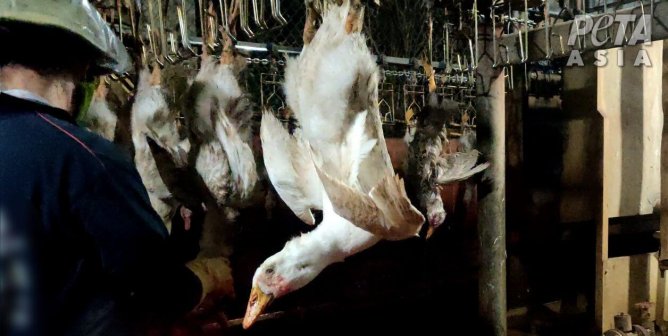The Mohair Industry
Mohair, the long, smooth fiber used in sweaters, hats, and other fluffy accessories, comes from angora goats (leading many to confuse it with angora wool, which comes from angora rabbits). Most of the world’s mohair originates in South Africa and the U.S. (particularly Texas), where angora goats are bred primarily for their soft inner coats, which are generally shorn twice a year, beginning as early as six months after birth.
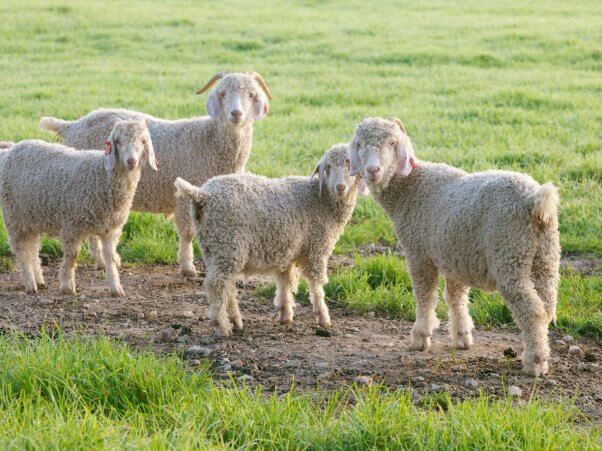
A PETA Asia eyewitness investigation of 12 angora goat farms in South Africa—the world’s top mohair producer—documented rampant abuse. Workers dragged goats by their horns and legs, threw them across the floor, mutilated them, and even cut the throats of fully conscious ones. Some shearers lifted the goats up off the floor by the tail, likely breaking it at the spine.
Goats are prey animals, which means that being pinned down during the shearing process is especially terrifying for them. Goat kids who were being shorn for the first time were heard screaming in pain and fear.
Workers in the mohair trade are paid by volume, not by the hour, so they’re driven to work quickly and carelessly. Shearers cut broad swaths of skin off some animals—and crudely stitched up the most gaping wounds right there on the filthy shearing floor, without providing any pain relief whatsoever. Workers also used tattoo pliers to punch sharp needles through goats’ ears to identify the animals, causing many to cry out in intense pain.
Goats deemed no longer profitable died agonizing deaths. One worker sawed through their throats with a dull knife and then broke their necks. Other goats were hauled to a slaughterhouse, jolted with electricity, hung upside down by one leg, slashed across the throat, bled, and skinned.
On some farms, workers also dehorn kids at the age of 1 or 2 weeks, typically by burning their horns off with a hot iron or applying a caustic chemical paste, which causes them to rub or scratch their heads in pain—potentially resulting in severe burns or blindness if the paste is transferred to their skin or eyes. Males also endure painful testicle removal using rubber rings, which leaves them in distress for days and often leads to tetanus infection. These procedures are usually carried out without any pain relief.
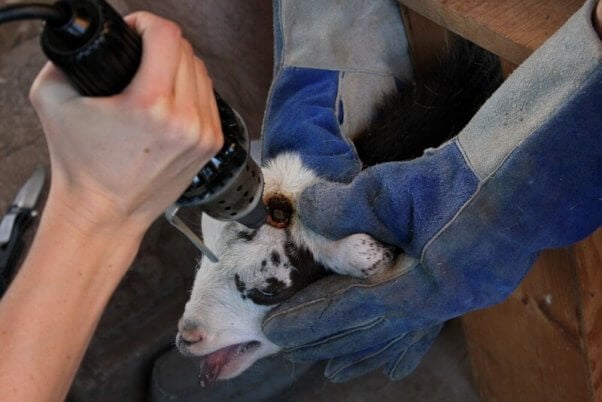
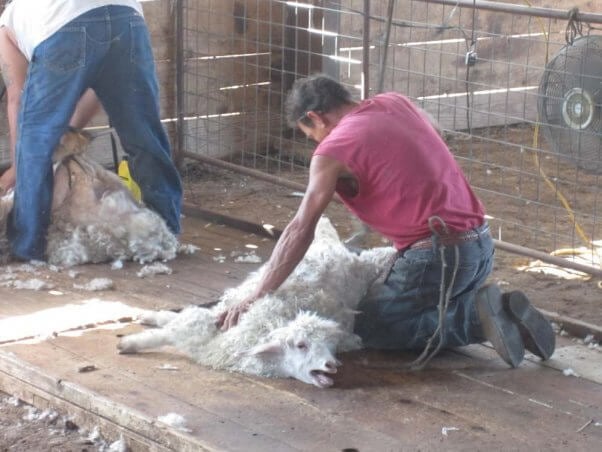
Shearing robs goats of their natural insulation, and unlike sheep, they don’t carry layers of body fat. They’re easily susceptible to internal parasites and cold temperatures, experiencing high mortality rates if left without shelter after shearing, as they often are. They’re so sensitive that summer winds and rain can kill them even when temperatures aren’t low, and shearing them in the winter causes many to die of pneumonia. Their hypothermia also makes them vulnerable to infections, nutritional deficiencies, and other often fatal problems. One worker told PETA Asia’s eyewitness that in just one weekend, 40,000 goats died of exposure across South Africa. Another said that up to 80 percent die after shearing on some farms.
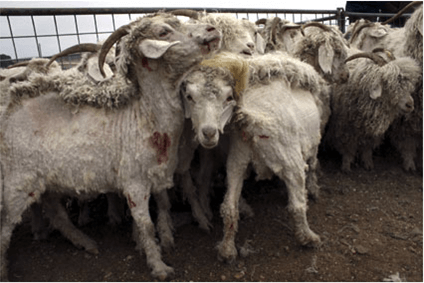
Angora goats used for mohair are killed well short of their natural 10-year life expectancy—as soon as they’re no longer useful to the industry because they cannot reproduce or because drought, illness, or several years of rough shearing have reduced the quality or regrowth rate of their hair. They’re often shorn one final time before being sold for meat, or they may be slaughtered for their skin, which is used to produce clothing, rugs, and other items. Buyers cram the animals into trucks for transport to slaughter and may drive for as long as 35 hours to get them to market as quickly as possible. At the slaughterhouse, they’re killed by captive bolt guns, electric shock, or direct throat slitting.
Some clothing producers and retailers claim that the animal hair and skins used in items that they sell are byproducts (rather than coproducts) of the meat industry. But although many angora goats are eventually slaughtered for meat, they’re raised specifically for their hair. No matter how animals are used as commodities—whether for the fashion industry or the meat industry—they don’t want to suffer while they’re alive and then eventually be slaughtered.
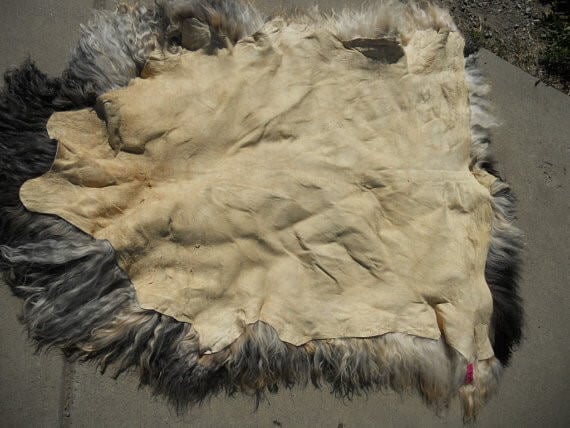
As mohair sales increase, the market for angora goat meat also expands—particularly for kid meat, known as capretto. Goats’ flesh may also be labeled chevon in meat markets in an attempt to portray it as a European “delicacy.” If you purchase mohair, you’re supporting an industry that slaughters animals for meat.
Mohair production is also a drain on resources and environmentally destructive. To produce 1 pound of mohair, goats must be fed between 40 and 50 pounds of high-quality feed grown on land that could instead be used to grow crops to feed humans. Land degradation as a result of overstocking and overgrazing is common.
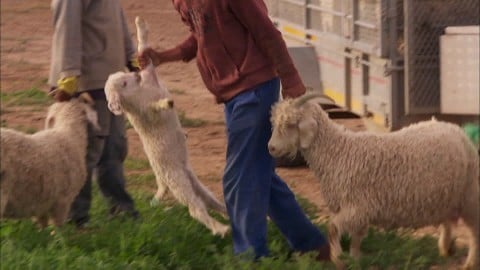
There’s no excuse for supporting an industry that abuses and kills millions of goats every year, especially when there are plenty of warm, cozy, and stylish fabrics available that aren’t made from mohair. Please join the millions of people all over the world who know that compassion is in fashion. Leave animal hair and skins out of your wardrobe and join the vegan fashion revolution today.
